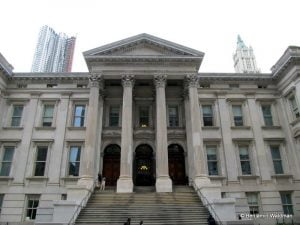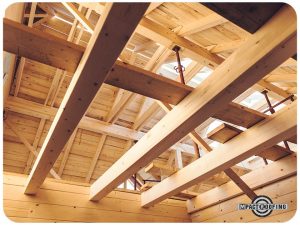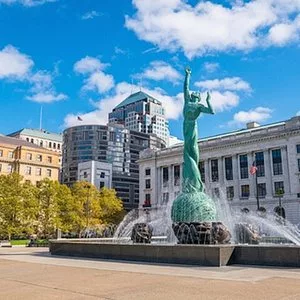Saint Paul’s Chapel, located at 209 Broadway, built in 1766, is one of the few surviving churches from New York City’s colonial era.
George Washington attended services here after taking the oath of office on April 30, 1789. During the Revolutionary War, it also served as a place of worship for both American and British officers.
In 1960, St. Paul’s Chapel was designated a National Historic Landmark. In 1966, it was designated a New York City Landmark and added to the National Register of Historic Places. Today, the Chapel is home to an active worshipping community.
273 Water Street in Fulton/Seaport [1773]
The Georgian-style house at 273 Water Street was built in 1773 by Captain Joseph Rose, a mahogany trader. At the time of its construction, long before landfills expanded the island, the East River ran just behind the property. In the 1860s, the building served as a tavern and gained notoriety as the home of Christopher Keyburn’s Sportsman’s Hall.
Due to its unsavory history, 273 Water Street was often referred to as the “Rat Pit.”
The property suffered significant damage from two fires, the first occurring in 1904 and the second in 1974. In 1976, the city seized the property for unpaid taxes, and it was eventually sold to a small private developer in 1997. Today, 273 Water Street is a four-unit condominium building. Apartment #2 sold for $ 1.7 million in March 2017.
18 Bowery in Chinatown [1785]
The Edward Mooney House, situated at 18 Bowery, dates back to 1785. It is New York City’s oldest surviving brick row house, dating back to the American Revolution shortly after the British evacuated New York. The home features a blend of pre-Revolutionary Georgian and Federal architectural styles.
279 Water Street in Fulton/Seaport [1794]
279 Water Street, built in 1794, coincides with George Washington’s second term as President of the United States. It predates the adjacent Brooklyn Bridge, which opened in 1883.
The structural beams of 279 Water were likely cut from first-growth timber that was around 200 years old at the time, meaning that some parts of the building may be over 400 years old. It is described as “New York City’s oldest commercial wood frame,” according to the owners of the Bridge Cafe, the most recent establishment to occupy 279 Water.
Hurricane Sandy damaged the building on October 29, 2012, and the Bridge Cafe has been closed ever since.
260 Broadway in Financial District [1811]
New York City Hall, situated at 260 Broadway, dates back to 1811. It is the oldest continuously operating city hall in the United States. The building houses the offices of the Mayor and the President of the City Council, along with meeting rooms for the City Council and Room No. 9, which is accessible to the press. New York City Hall is designated as both a New York City Landmark and a National Historic Landmark, and it is listed on the National Register of Historic Places.
3 Henry Street in Two Bridges [1845]
Mariner’s Temple, situated at the corner of 3 Henry Street and 12 Oliver Street in Lower Manhattan, is a Baptist church built in 1845. It is located in the Two Bridges neighborhood of downtown, near Bowery, the Lower East Side, and Chinatown. The building exemplifies simplistic Greek Revival architecture and was initially known as the Oliver Street Baptist Church.
172 Norfolk Street in the Lower East Side [1849]
Erected in 1849, 172 Norfolk Street is home to the Angel Orensanz Center, a landmark art and performance space in the Lower East Side.
It is the oldest surviving synagogue building in New York City, occasionally still used for this purpose today. Built in the Gothic Revival style, it was the largest synagogue building in America at the time of its completion. The building was abandoned in 1974 and was subsequently purchased by Spanish painter and sculptor Angel Orensanz, who restored and repurposed the structure.
157 East 78th Street on the Upper East Side [1861]
157 East 78th Street is part of the East 78th Street Houses, a row of five attached brick houses constructed as part of an original group of 11 built in 1861. These houses are recognized as New York City landmarks and are also listed on the National Register of Historic Places. They are considered some of the oldest townhouses on the Upper East Side of Manhattan.
208-218 East 78th Street on the Upper East Side [1865]
208-218 East 78th Street comprises six attached brick rowhouses, designed in the Italianate style. This collection represents the second-oldest group of buildings on the Upper East Side, as they are the last surviving structures from a total of 15 built as affordable housing in the early 1860s. These rowhouses are designated as a New York City landmark and are listed on the National Register of Historic Places.
129 East 17th Street in Gramercy Park. [1879]
Built in 1879, 129 East 17th Street is regarded by some as the oldest surviving genteel apartment house in New York City. This five-story structure, made of brick and brownstone, is designed in the French Gothic Revival style. At the time of its construction, apartment living was relatively uncommon among the middle class, and the Gramercy Park neighborhood was primarily composed of row houses.
To attract middle-class residents, the building featured upscale design elements, such as intricately carved marble mantels, setting it apart from the more typical tenement buildings that catered to lower-income individuals. 129 East 17th Street was designed by American architect Napoleon Le Brun, who also created several French Gothic-style firehouses throughout New York City.
58 Rivington Street in the Lower East Side [1904]
The Adath Jeshurun of Jassy Synagogue, located at 58 Rivington Street, was built in 1904 and designed by architect Emery Roth. It showcases Moorish Revival architecture. The building was abandoned in the mid-1970s until Hale Gurland purchased it in 1979. It has since been transformed into residences and artists’ studios, which remain in use today.
280 Broome Street in the Lower East Side [1927]
Built between 1926 and 1927, 280 Broome Street is home to the Kehila Kadosha Janina Synagogue, the only synagogue of the Romaniote rite in the Western Hemisphere. It was constructed by a small group of Romaniote Jews who emigrated from the town of Ioannina in northwestern Greece. The synagogue was designated as a New York City landmark on May 11, 2004, and it is also listed on the National Register of Historic Places.
 nts that shaped this iconic city
nts that shaped this iconic city 1869, is another famous museum that showcases the city’s history and cultural heritage.
1869, is another famous museum that showcases the city’s history and cultural heritage.

